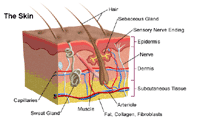First-Degree Burns
What is a superficial first-degree burn?
Superficial first-degree burns affect only the epidermis, or outer layer of skin. The burn site is red, painful, dry, and with no blisters. Mild sunburn is an example. Long-term tissue damage is rare and usually consists of an increase or decrease in the skin color.

What causes a superficial first-degree burn?
In most cases,superficial first-degree burns are caused by the following:
Mild sunburn
Flash burn -- a sudden, brief burst of heat
What are the symptoms of a superficial first-degree burn?
The following are the most common signs and symptoms of a superficial first-degree burn. However, each child may experience symptoms differently. Symptoms may include:
Redness
Dry skin
Skin that is painful to touch
Pain usually lasts 48 to 72 hours and then subsides
Peeling skin
The symptoms of a first-degree burn may resemble other conditions or medical problems. Consult your child's doctor for a diagnosis.
Treatment for superficial first-degree burns
Specific treatment for a superficial first-degree burn will be determined by your child's doctor, based on the following:
Your child's age, overall health, and medical history
Extent of the burn
Location of the burn
Cause of the burn
Your child's tolerance for specific medications, procedures, or therapies
Your opinion or preference
Superficial first-degree burns usually heal on their own within a week. Treatment may depend on the severity of the burn and may include the following:
Cold compresses
Lotion or ointments
Acetaminophen or ibuprofen
Superficial first-degree burns are usually not bandaged. Consult your child's doctor for additional treatment for first-degree burns.